Could I have been Mary Seacole? A vibrant yet largely forgotten influence alongside Florence Nightengale
A Black nurse's perspective during the Crimean war, whose light shone just as bright as Nightengale's.
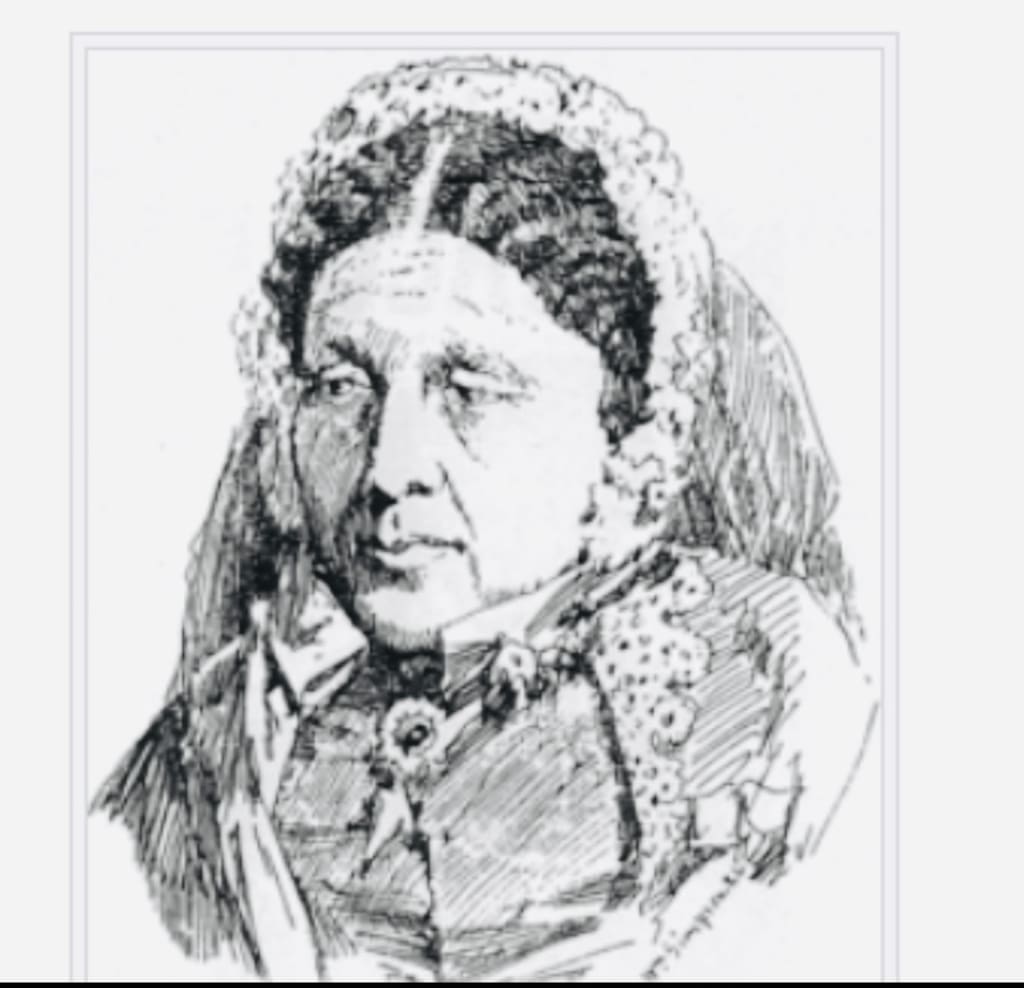
Mary lived within the same time as Florence Nightengale. Her story differs greatly from the affluence and white privilege which surrounded Nightengale. Nevertheless, she persevered, despite the obvious bias, bigotry, prejudice and racial divide which pervaded her every step.
I would have gladly stepped into the shoes of both of these women given the depth of care and heartfelt emotions which went into the lives which they chose to pursue.
Like Olaudah Equiano: "See, here is Mary Seacole, who did as much in the Crimea as another magic-lamping lady, but, being dark, could scarce be seen for the flame of Florence's candle".
Mary Jane Seacole ( 23 November 1805 – 14 May 1881) was a British-Jamaican nurse and businesswoman who set up the "British Hotel" behind the lines during the Crimean War. She described the hotel as "a mess-table and comfortable quarters for sick and convalescent officers", and provided succor for wounded service men on the battlefield, nursing many of them back to health. Coming from a tradition of Jamaican and West African "doctresses", Seacole displayed "compassion, skills and bravery while nursing soldiers during the Crimean War", through the use of herbal remedies. She was posthumously awarded the Jamaican Order of Merit in 1990. In 2004, she was voted the greatest black Briton in a survey conducted in 2003 by the black heritage website Every Generation.
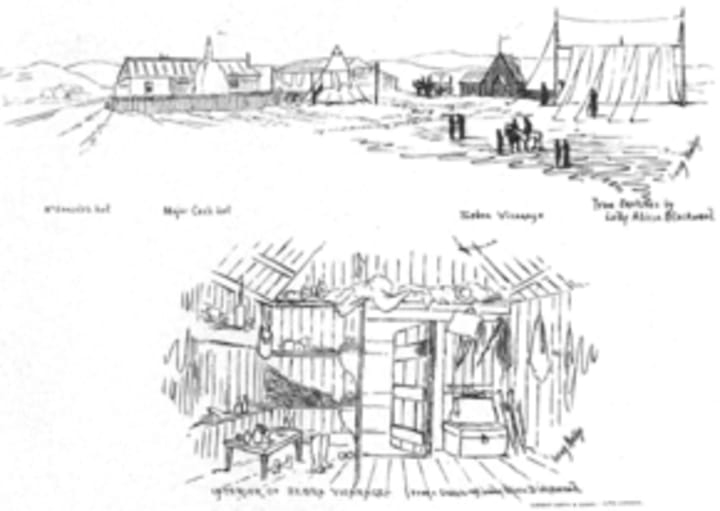
Sketch of Mary Seacole's British Hotel in Crimea, by Lady Alicia Blackwood (1818–1913), a friend of Florence Nightingale's who resided in the neighboring "Zebra Vicarage".
It has been argued that Seacole was the first British nurse practitioner (in the sense of a practicing nurse with advanced medical skills). Hoping to assist with nursing the wounded on the outbreak of the Crimean War, Seacole applied to the War Office to be included among the nursing contingent but was refused, so she travelled independently and set up her hotel and tended to the battlefield wounded. She became popular among service personnel, who raised money for her when she faced destitution after the war. In 1857 a four-day fundraising gala took place in London to honour Seacole. About 40,000 attended, including veterans.
She was largely forgotten for almost a century after her death. Her autobiography, Wonderful Adventures of Mrs. Seacole in Many Lands (1857), was the first autobiography written by a black woman in Britain. The erection of a statue of her at St Thomas' Hospital, London, on 30 June 2016, describing her as a "pioneer", generated some controversy and opposition, especially among those concerned with Florence Nightingale's legacy.
One woman has been revered throughout history for her accomplishment, while the other was largely forgotten. Yet, a statue of a black woman brings controversy to a world of naysayers who were not present in the days when people fought to aid and assist the ones who fought so that we all may enjoy relative peace today.
Why should one be more deserving than the other. One woman had privilege on her side, the other struggled to take what she wanted. Why would anyone begrudge her a monument to her bravery.
Mary Seacole meets Florence Nightengale
According to some secondary sources, Nightingale had a frosty relationship with her fellow nurse Mary Seacole, who ran a hotel/hospital for officers. Seacole's own memoir, Wonderful Adventures of Mrs. Seacole in Many Lands, records only one, friendly, meeting with her, when she asked her for a bed for the night and got it; Seacole was in Scutari en route to the Crimea to join her business partner and start their business. However, Seacole pointed out that when she tried to join Nightingale's group, one of Nightingale's colleagues rebuffed her, and Seacole inferred that racism was at the root of that rebuttal. Nightingale told her brother-in-law, in a private letter, that she was worried about contact between her work and Seacole's business, claiming that while "she was very kind to the men and, what is more, to the Officers – and did some good (she) made many drunk".
Nightingale reportedly wrote, "I had the greatest difficulty in repelling Mrs. Seacole's advances, and in preventing association between her and my nurses (absolutely out of the question!)...Anyone who employs Mrs. Seacole will introduce much kindness – also much drunkenness and improper conduct".
On the other hand, Seacole told the French chef Alexis Soyer that "You must know, M Soyer, that Miss Nightingale is very fond of me. When I passed through Scutari, she very kindly gave me board and lodging".
Perspectives of liaisons differ, depending on whom you may ask. I greatly admire Mary for uttering only positive thoughts on her meeting with her counterpart Florence.
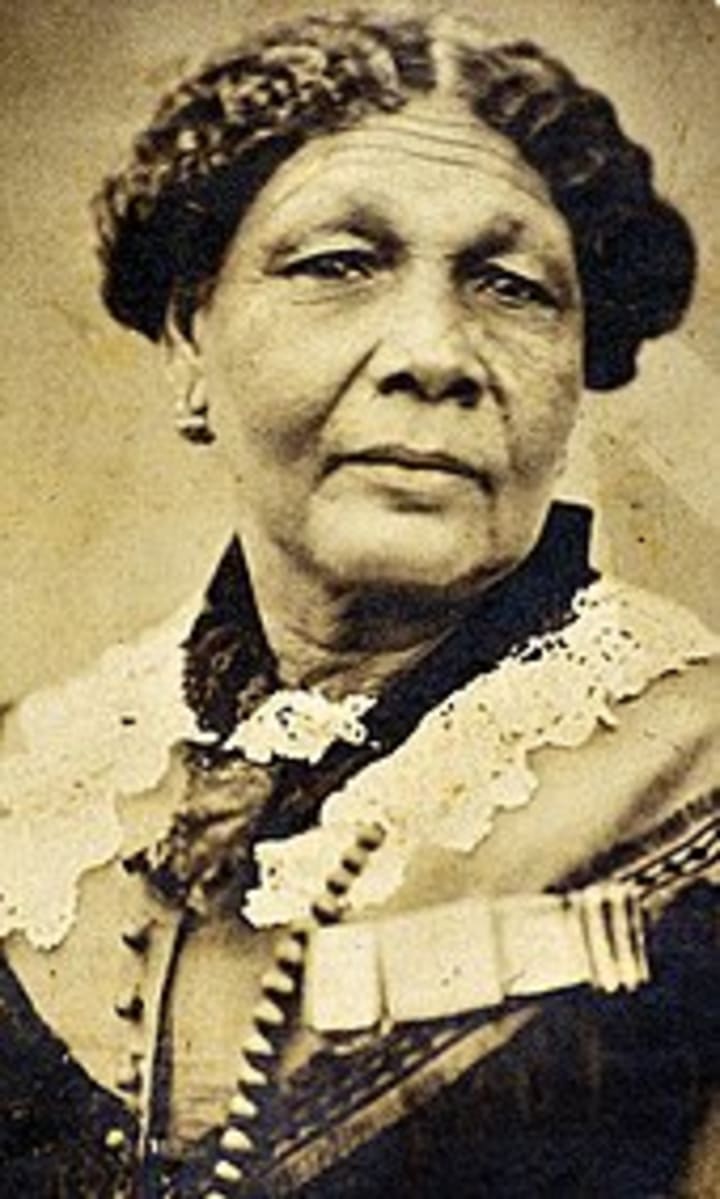
Mary Jane Seacole was born Mary Jane Grant on 23 November 1805 in Kingston, in the Colony of Jamaica as a member of the community of free black people in Jamaica. She was the daughter of James Grant, a Scottish Lieutenant in the British Army. Her mother, Mrs. Grant, nicknamed "The Doctress", was a healer who used traditional Caribbean and African herbal medicines. Mrs. Grant also ran Blundell Hall, a boarding house at 7, East Street.
In the 18th century, Jamaican doctresses mastered folk medicine, including the use of hygiene and herbs. They had a vast knowledge of tropical diseases, and had a general practitioner's skill in treating ailments and injuries, acquired from having to look after the illnesses of fellow slaves on sugar plantations. At Blundell Hall, Seacole acquired her nursing skills, which included the use of hygiene, ventilation, warmth, hydration, rest, empathy, good nutrition and care for the dying. Blundell Hall also served as a convalescent home for military and naval staff recuperating from illnesses such as cholera and yellow fever. Seacole's autobiography says she began experimenting in medicine, based on what she learned from her mother, by ministering to a doll and then progressing to pets before helping her mother treat humans.
Because of her family's close ties with the army, she was able to observe the practices of military doctors, and combined that knowledge with the West African remedies she acquired from her mother. In Jamaica in the late 18th and early 19th centuries, neonatal deaths were more than a quarter of total births. However, Seacole, using traditional West African herbal remedies and hygienic practices, reported that she never lost a mother or her child.
Mary was proud of both her Jamaican and Scottish ancestry and called herself a Creole. "I am a Creole, and have good Scots blood coursing through my veins. My father was a soldier of an old Scottish family". Her biographer Jane Robinson speculates that she may technically have been a quadroon. Seacole emphasizes her personal vigor in her autobiography, distancing herself from the contemporary stereotype of the "lazy Creole". She was proud of her black ancestry, writing, "I have a few shades of deeper brown upon my skin which shows me related – and I am proud of the relationship – to those poor mortals whom you once held enslaved, and whose bodies America still owns".
As the educated daughter of a Scottish officer and a free black woman with a respectable business, Seacole would have held a high position in Jamaican society.
During 1843 and 1844, Seacole suffered a series of personal disasters. She and her family lost much of the boarding house in a fire in Kingston on 29 August 1843. Blundell Hall burned down, and was replaced by New Blundell Hall, which was described as "better than before". Then her husband died in October 1844, followed by her mother. After a period of grief, in which Seacole says she did not stir for days, she composed herself, "turned a bold front to fortune", and assumed the management of her mother's hotel. She put her rapid recovery down to her hot Creole blood, blunting the "sharp edge of [her] grief" sooner than Europeans who she thought "nurse their woe secretly in their hearts".
Seacole absorbed herself in work, declining many offers of marriage. She later became known to the European military visitors to Jamaica who often stayed at Blundell Hall. She treated and nursed patients in the cholera epidemic of 1850, which killed some 32,000 Jamaicans.
In 1851, Seacole travelled to Cruces to visit her brother. Shortly after her arrival, the town was struck by cholera, a disease which had reached Panama in 1849. Seacole was on hand to treat the first victim, who survived, which established Seacole's reputation and brought her a succession of patients as the infection spread. The rich paid, but she treated the poor for free. Many, both rich and poor, succumbed. She eschewed opium, preferring mustard rubs and poultices, the laxative calomel (mercurous chloride), sugars of lead (lead(II) acetate), and rehydration with water boiled with cinnamon. While her preparations had moderate success, she faced little competition, the only other treatments coming from a "timid little dentist", who was an inexperienced doctor sent by the Panamanian government, and the Roman Catholic Church.
The epidemic raged through the population. Seacole later expressed exasperation at their feeble resistance, claiming they "bowed down before the plague in slavish despair". She performed an autopsy on an orphan child for whom she had cared, which gave her "decidedly useful" new knowledge. At the end of this epidemic, she herself contracted cholera, forcing her to rest for several weeks. In her autobiography, she describes how the residents of Cruces responded: "When it became known that their "yellow doctress" had the cholera, I must do the people of Cruces the justice to say that they gave me plenty of sympathy, and would have shown their regard for me more actively, had there been any occasion.
Meeting with disappointments, yet persevering
Seacole also applied to the Crimean Fund, a fund raised by public subscription to support the wounded in Crimea, for sponsorship to travel there, but she again met with refusal. Seacole questioned whether racism was a factor in her being turned down. She wrote in her autobiography, "Was it possible that American prejudices against colour had some root here? Did these ladies shrink from accepting my aid because my blood flowed beneath a somewhat duskier skin than theirs"? An attempt to join the contingent of nurses was also rebuffed, as she wrote, "Once again I tried, and had an interview this time with one of Miss Nightingale's companions. She gave me the same reply, and I read in her face the fact, that had there been a vacancy, I should not have been chosen to fill it". Seacole did not stop after being rebuffed by the Secretary-at-War, she soon approached his wife, Elizabeth Herbert, who also informed her "that the full complement of nurses had been secured".
Apart from serving officers at the British Hotel, Seacole also provided catering for spectators at the battles, and spent time on Cathcart's Hill, some 3+1⁄2 miles (5.6 km) north of the British Hotel, as an observer. On one occasion, attending wounded troops under fire, she dislocated her right thumb, an injury which never healed entirely. In a dispatch written on 14 September 1855, William Howard Russell, special correspondent of The Times, wrote that she was a "warm and successful physician, who doctors and cures all manner of men with extraordinary success. She is always in attendance near the battlefield to aid the wounded and has earned many a poor fellow's blessing." Russell also wrote that she "redeemed the name of sutler", and another that she was "both a Miss Nightingale and a [chef]". Seacole made a point of wearing brightly colored, and highly conspicuous, clothing—often bright blue, or yellow, with ribbons in contrasting colours While Lady Alicia Blackwood later recalled that Seacole had "... personally spared no pains and no exertion to visit the field of woe, and minister with her own hands such things as could comfort or alleviate the suffering of those around her; freely giving to such as could not pay.
Her peers, though wary at first, soon found out how important Seacole was for both medical assistance and morale. One British medical officer described Seacole in his memoir as "The acquaintance of a celebrated person, Mrs. Seacole, a coloured women who out of the goodness of her heart and at her own expense, supplied hot tea to the poor sufferers [wounded men being transported from the peninsula to the hospital at Scutari ] while they are waiting to be lifted into the boats…. She did not spare herself if she could do any good to the suffering soldiers. In rain and snow, in storm and tempest, day after day she was at her self-chosen post with her stove and kettle, in any shelter she could find, brewing tea for all who wanted it, and they were many. Sometimes more than 200 sick would be embarked in one day, but Mrs. Seacole was always equal, to the occasion". But Seacole did more than carry tea to the suffering soldiers. She often carried bags of lint, bandages, needles and thread to tend to the wounds of soldiers.
In late August, Seacole was on the route to Cathcart's Hill for the final assault on Sevastopol on 7 September 1855. French troops led the storming, but the British were beaten back. By dawn on Sunday 9 September, the city was burning out of control, and it was clear that it had fallen: the Russians retreated to fortifications to the north of the harbour. Later in the day, Seacole fulfilled a bet, and became the first British woman to enter Sevastopol after it fell. Having obtained a pass, she toured the broken town, bearing refreshments and visiting the crowded hospital by the docks, containing thousands of dead and dying Russians. Her foreign appearance led to her being stopped by French looters, but she was rescued by a passing officer. She looted some items from the city, including a church bell, an altar candle, and a three-metre (10 ft) long painting of the Madonna.
Seacole was joined by a 14-year-old girl, Sarah, also known as Sally. Soyer described her as "the Egyptian beauty, Mrs Seacole's daughter Sarah", with blue eyes and dark hair. Nightingale alleged that Sarah was the illegitimate offspring of Seacole and Colonel Henry Bunbury. However, there is no evidence that Bunbury met Seacole, or even visited Jamaica, at a time when she would have been nursing her ailing husband.
Why couldn't these two women have worked together? What would they have achieved together, we will never know.
In researching his biography of Florence Nightingale, the first major biography in fifty years, Mark Bostridge uncovered a letter in the archive at the home of Nightingale's sister Parthenope, which showed that Nightingale had made a contribution to Seacole's fund, indicating that she saw value at that time in Seacole's work in the Crimea.
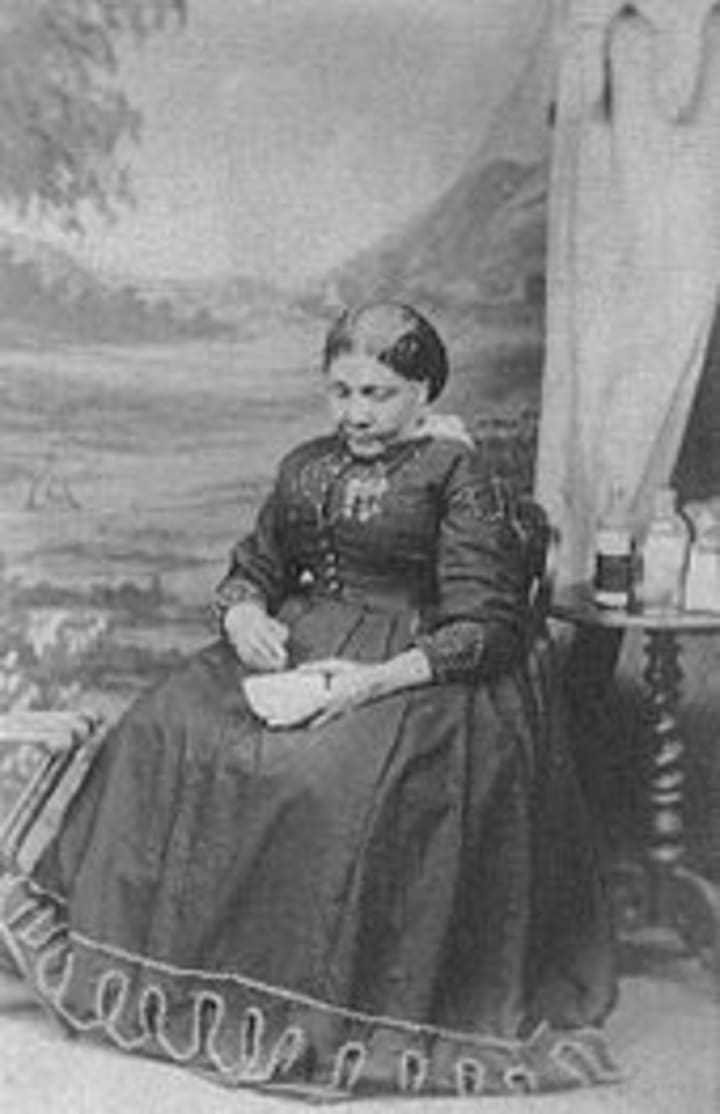
One of two known photographs of Mary Seacole, taken for a carte de visite by Maull & Company in London (c. 1873).
In the census of 3 April 1881, Seacole is listed as a boarder at 3 Cambridge Street, Paddington. Seacole died on 14 May 1881 at her home, 3 Cambridge Street (later renamed Kendal Street) in Paddington, London; the cause of death was noted as "apoplexy".
While well known at the end of her life, Seacole rapidly faded from public memory in Britain. She was cited as an example of "hidden" black history in Salman Rushdie's The Satanic Verses (1988).
She has been better remembered in Jamaica, where significant buildings were named after her in the 1950s: the headquarters of the Jamaican General Trained Nurses' Association was christened "Mary Seacole House" in 1954, followed quickly by the naming of a hall of residence of the University of the West Indies in Mona, Jamaica, and a ward at Kingston Public Hospital was also named in her memory. More than a century after her death, Seacole was posthumously awarded the Jamaican Order of Merit in 1990.
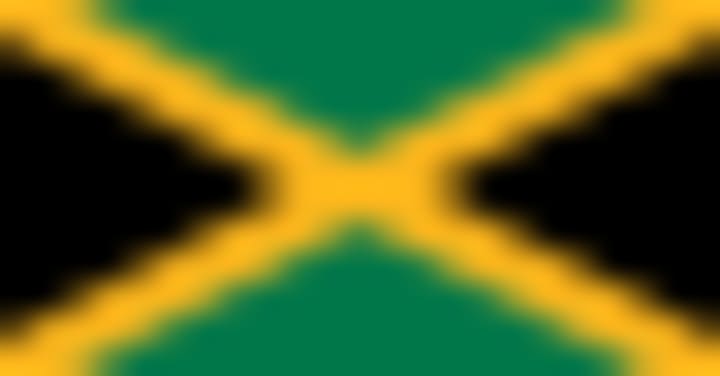
Jamaican Order of Merit
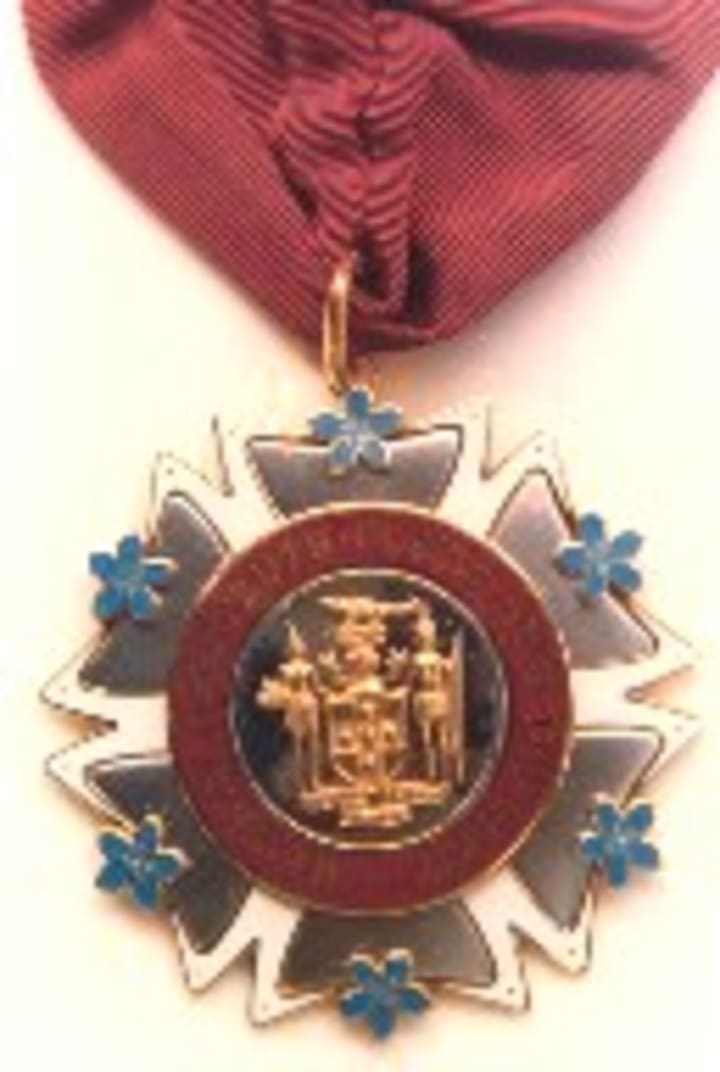
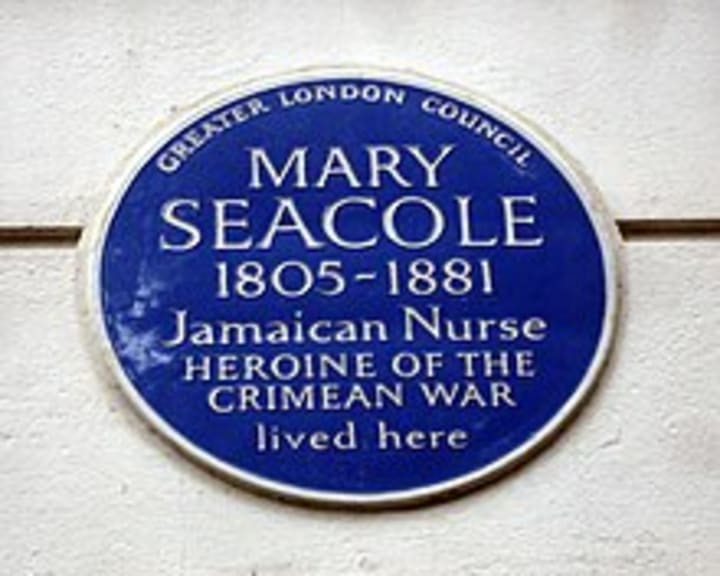
Plaque commemorating Mary Seacole at 14 Soho Square, London W1.
.....................................................
Excerpts.
About the Creator
Novel Allen
Clouds come floating into my life, no longer to carry rain or usher storm, but to add color to my sunset sky. ~~ Rabindranath Tagore~~
Enjoyed the story? Support the Creator.
Subscribe for free to receive all their stories in your feed. You could also pledge your support or give them a one-off tip, letting them know you appreciate their work.
Reader insights
Outstanding
Excellent work. Looking forward to reading more!
Top insights
Compelling and original writing
Creative use of language & vocab
Easy to read and follow
Well-structured & engaging content
Eye opening
Niche topic & fresh perspectives
Heartfelt and relatable
The story invoked strong personal emotions
Masterful proofreading
Zero grammar & spelling mistakes
On-point and relevant
Writing reflected the title & theme
Excellent storytelling
Original narrative & well developed characters
Expert insights and opinions
Arguments were carefully researched and presented

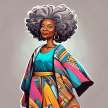
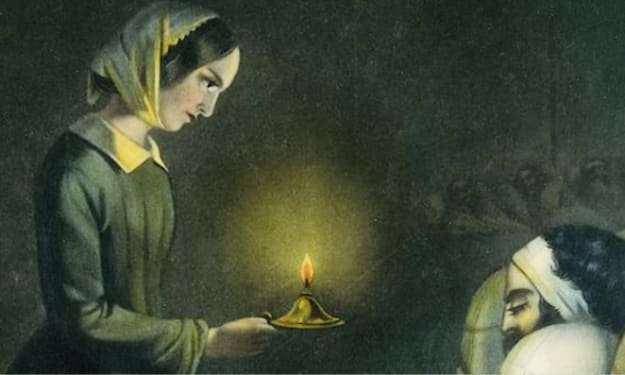



Comments (6)
What an amazing woman. Her story was fascinating. I never would have known about this hero this angel of medicine if not for this so thank you for introducing her to me
O-N ~ Where you Bin? Thanks for all of your 'Global' Learnin' ~ I've always told my 'Pro-Bono' students ~ "I never learn anything by just listening to myself" and always encourage them to 'Check Me' - I learn from them - It's always a pleasure to "LiSTeN" to your so-sage "Novel-Approach" - My Twin, Lucky Lar, recently sponsored a major Maya Angelou production - Hey, I did my own 'Schtick-Art'...Terrilynn's got nuthin' on me! ~ "Dear Dad" ~ I don't know if you celebrate 'Fathers' day on your side of the Globe ~ But, it's so meaningful to pull long-term memories out of the Recollection-Department at this stage. - Always with such Respect - J-BuD Jay Kantor, Chatsworth, California 'Senior' Vocal Author - Vocal Author Community
OMGGGGG! I cannot believe Florence Nightingale actually did that to Mary Seacole! 😱😱😱😱😱😱 What Mary had experiencely was extremely unfair! I kinda feel guilty now for having not heard of Mary before. But I'm so glad that through you, I learned about her. Thank you so much for this, Novlet! 🥺❤️
Thanks for sharing this little known bit of history. I'd never heard of Mary Seacole, but am not at all surprised she's been overlooked by white Western history.
Thank you for covering her story. It is still amazing to me how many people know nothing about her and the life she led.
waoooooooooooo